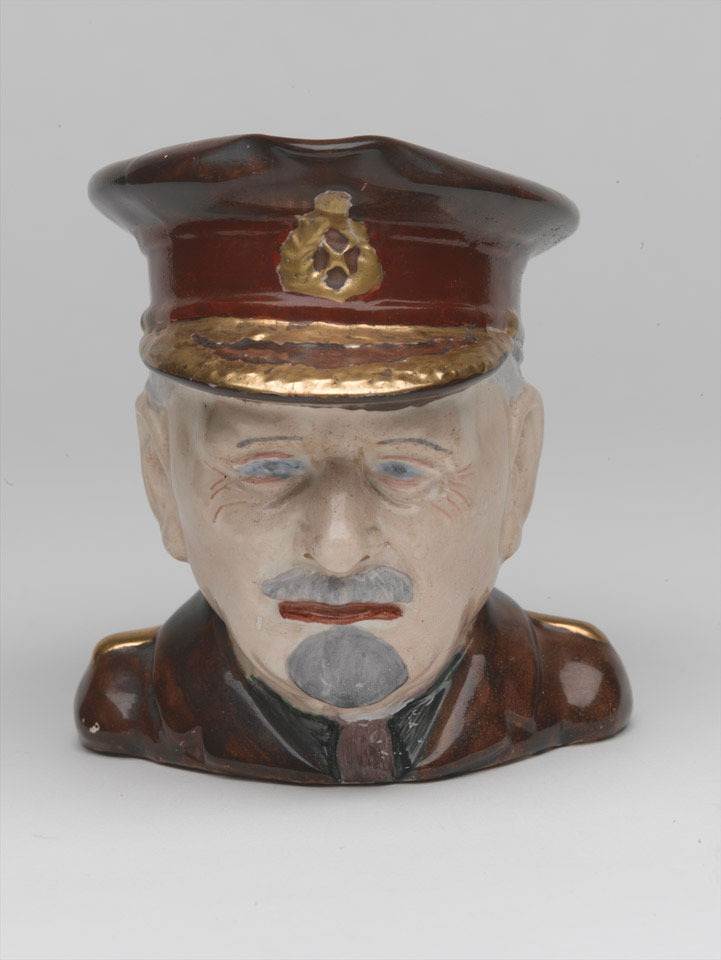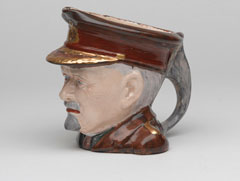
Online Collection
« Prev - 1 of 1 results - Next »
Earthenware Toby jug, a portrait head of Field Marshal Jan Smuts, 1941 (c)
Handpainted, unmarked and made, 1941 (c).
After attending Cambridge, Smuts (1870-1950) went into legal practice in Johannesburg in 1896. His abilities and anti-British outlook following the Jameson Raid brought him to the notice of President Kruger, who appointed him State Attorney of the South African Republic in 1898.
During the Boer War (1899-1902) he demonstrated a talent for guerrilla warfare, his most famous raid taking him far into Cape Colony. As well as being one of the Boers' best soldiers, Smuts was one of their negotiators who signed the Vereeniging peace treaty (1902).
After the war he was content to fight the Afrikaner cause via politics, eventually concluding that South Africa's future lay within the British Empire. Alongside General Louis Botha he convinced the Boer hardliners to agree to the Union of South Africa (1909). Smuts became Minister of Defence, Mines and the Interior and created the Union Defence Force. Although something of a reserved intellectual, he possessed a ruthless streak, clamping down on Ghandi's campaign, declaring martial law during the 1914 miners' strike, and putting down the Maritz revolt against allying with Britain during World War One.
Smuts then formed the South African Defence Force and in 1915 he and Botha conquered German South West Africa. In 1916 Smuts commanded the conquest of German East Africa, but despite mobilising a large force he struggled to defeat Colonel Paul von Lettow-Vorbeck's guerillas. Smuts was criticised by some of his contemporaries for dragging out the campaign longer than was necessary, resulting in many deaths from illness. Von Lettow-Vorbeck was still at large when Smuts left to join the Imperial War Cabinet in 1917. The following year he helped create the Royal Air Force.
Smuts attended the Paris Peace Conference (1919) and favoured reconciliation with Germany and limited reparations. He was also a leading proponent of a League of Nations. Resuming his political career after the war, Smuts was Prime Minister of South Africa from 1919 until 1924. Returning to coalition government as Deputy Prime Minster in 1933, Smuts was re-appointed Prime Minster in September 1939 after J. B. M Hertzog's resignation over the neutrality question. He joined the Imperial War Cabinet again and his influence was such that there was a plan, hatched in 1940, that if Churchill died, Smuts would succeed him as Prime Minister. He was appointed a British field marshal in May 1941. Smuts again signed the peace settlement, becoming the only individual to sign both peace treaties after the World Wars.
His major post-war achievement was drafting the Covenant of the United Nations, helping ensure that unlike the League of Nations the new body had real power. Although Smuts had originally advocated racial segregation and opposed the enfranchisement of black Africans, his views changed and he backed the Fagan Report's (1946) findings that complete segregation was impossible. Smuts subsequently lost the 1948 election to hard-line Afrikaners who created apartheid. He continued to work for reconciliation and emphasised the British Commonwealth's positive role until his death in 1950.
NAM Accession Number
NAM. 2006-08-38-1
Copyright/Ownership
National Army Museum Copyright
Location
National Army Museum, Study collection
Object URL
https://collection.nam.ac.uk/detail.php?acc=2006-08-38-1


